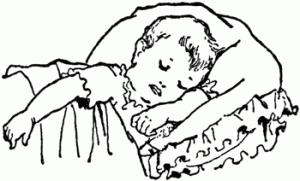I never thought about children snoring until I heard a public service announcement on the radio the other day.
I did some research on the subject and want to share what I found out as it might be an area of concern if you have a young child who snores. My research source…The National Sleep Foundation (NSF).
According to NSF, children, three years old or older tend to snore during the deeper stages of sleep. Primary snoring is defined as snoring that is not associated with more serious problems such as obstructive sleep apnea syndrome (OSAS), frequent waking from sleep, or inability of the lungs to breathe in sufficient oxygen.

About one to three percent of children not only snore, but also suffer from breathing problems during their sleep.
The American Academy of Pediatrics recommends that children be screened for snoring and that a diagnosis be conducted to determine if a child is experiencing normal primary snoring or obstructive sleep apnea syndrome. Loud and regular nightly snoring is often abnormal in otherwise healthy children and could be a sign of a respiratory infection, a stuffy nose or allergy; other times it may be a symptom of sleep apnea.
In children, the most common physical problem associated with sleep apnea is large tonsils. Young children’s tonsils are quite large in comparison to the throat, peaking at five to seven years of age. Swollen tonsils can block the airway, making it difficult to breathe and could signify apnea.
According to the National Center for Health Statistics, more than 263,000 children in the U.S. have tonsillectomies each year and sleep apnea is a major reason.
A child suffering from sleep apnea may experience the following symptoms:
- Loud snoring on a regular basis
- Have pauses, gasps, and snorts and actually stop breathing. The snorts or gasps may waken them and disrupt their sleep.
- Be restless or sleep in abnormal positions with their head in unusual positions.
- Sweat heavily during sleep.
The daytime effects of sleep apnea in children may manifest themselves in ways such as:
- Experiencing behavioral, school and social problems
- Being difficult to wake up
- The child suffering headaches during the day, but especially in the morning
- Your child being irritable, agitated, aggressive, and cranky
- Being so tired during the day that they fall asleep or daydream
- Speaking with a nasal voice and breathe regularly through the mouth
If your child has any of the above symptoms, the National Sleep Foundation suggests speaking with your child’s physician.

